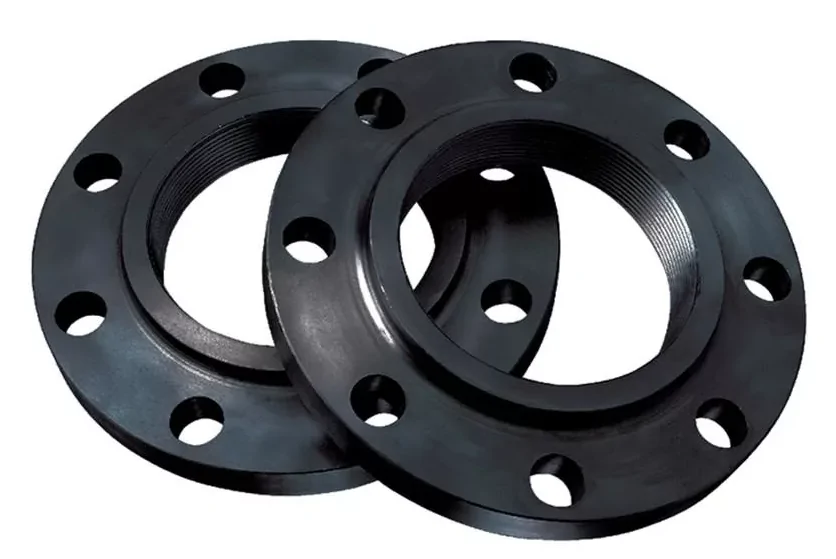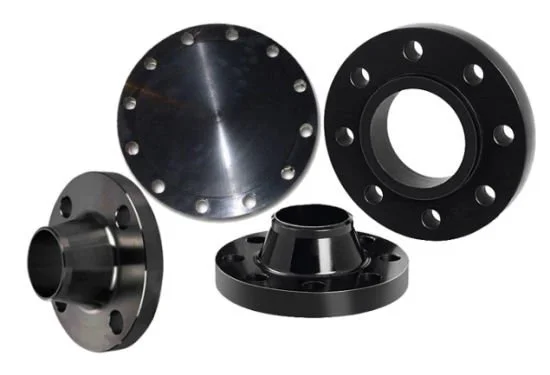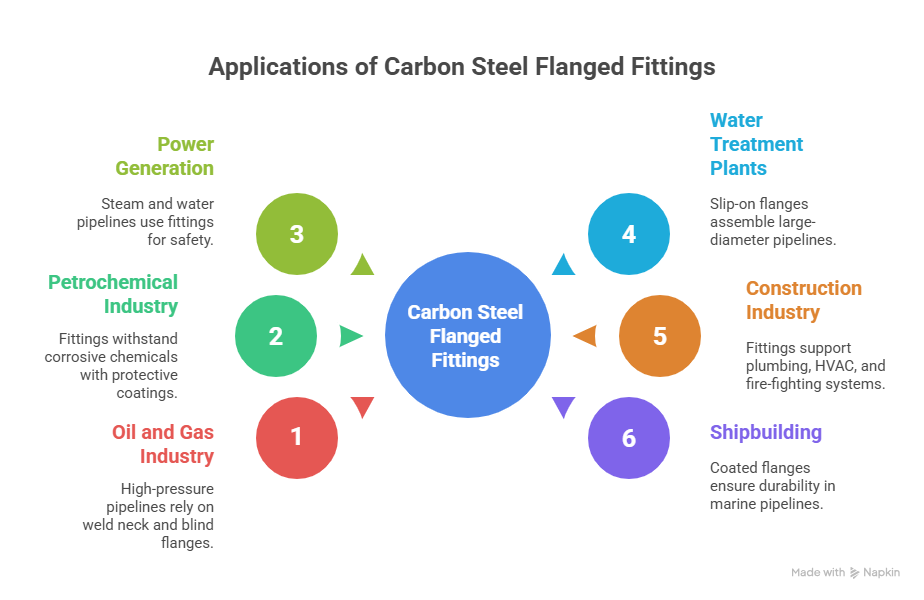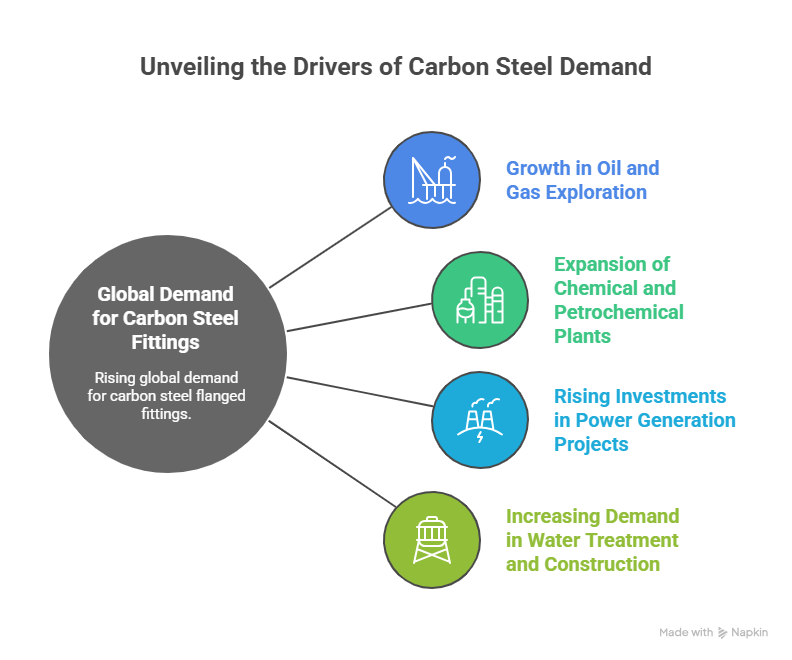Introduction
Carbon steel flanged fittings play a vital role in modern piping systems. These fittings ensure leak-proof connections between pipelines, valves, and equipment. Industries prefer carbon steel because of its strength, durability, and cost-effectiveness.
Fortis Forge, a trusted supplier of industrial fittings, provides high-quality carbon steel flanged fittings for global industries. These fittings comply with international standards, making them reliable for demanding applications.
This blog explores carbon steel flanged fittings, their types, applications, benefits, and market trends.
What Are Carbon Steel Flanged Fittings?
Carbon steel flanged fittings connect pipes and equipment using flanges. A flange is a projecting rim that allows bolted connections. These fittings make assembly and disassembly easier, unlike welded joints.
Carbon steel offers excellent tensile strength and resistance to stress. Its high hardness ensures long service life in high-pressure systems.
Key Features:
Strong mechanical strength
Easy installation and replacement
Corrosion resistance with proper coatings
Compatibility with different pressure classes

Types of Carbon Steel Flanged Fittings
Industries use different flanged fittings depending on design, function, and system requirements.
1. Weld Neck Flanged Fittings
These fittings feature a long tapered hub. They reduce stress concentration at the base of the flange. Weld neck flanges are ideal for high-pressure and high-temperature applications.
2. Slip-On Flanged Fittings
Slip-on flanges are easy to install and align. They fit over the pipe and are welded inside and outside. These fittings work well in low-pressure systems.
3. Blind Flanged Fittings
Blind flanges close the end of a piping system. They allow access for inspection, cleaning, or future extensions.
4. Socket Weld Flanged Fittings
These fittings hold pipes inside the socket and are fillet welded. They offer strong leak-proof connections for small-diameter pipelines.
5. Threaded Flanged Fittings
Threaded flanges connect pipes without welding. They are suitable for explosive environments where welding is risky.
6. Lap Joint Flanged Fittings
Lap joint flanges work with stub ends. They allow easy alignment and are cost-effective for low-pressure applications.

Applications of Carbon Steel Flanged Fittings
Carbon steel flanged fittings are used in diverse industries due to their reliability.
Oil and Gas Industry
High-pressure pipelines in oil refineries depend on weld neck and blind flanges.
Petrochemical Industry
Carbon steel flanged fittings withstand corrosive chemicals with protective coatings.
Power Generation
Steam and water pipelines in thermal and nuclear plants use flanged fittings for safety.
Water Treatment Plants
Slip-on flanges help assemble large-diameter pipelines with ease.
Construction Industry
Flanged fittings support plumbing, HVAC, and fire-fighting systems
Shipbuilding
Marine pipelines use coated carbon steel flanges for durability in harsh conditions.

Advantages of Carbon Steel Flanged Fittings
Durability—Carbon steel withstands mechanical stress and impact.
Cost-Effective—It offers strength at a lower cost than stainless steel.
Versatility—Compatible with a wide range of industries and applications.
Easy Installation—Flanged connections simplify assembly and replacement.
Safety—Leak-proof joints reduce risks in hazardous environments.
Carbon Steel Grades Used in Flanged Fittings
Different grades of carbon steel serve different purposes.
ASTM A105 – Commonly used for forged flanges.
ASTM A350 LF2 – Suitable for low-temperature services.
ASTM A694 F52–F70—Used in high-pressure transmission pipelines.
Standards for Carbon Steel Flanged Fittings
Carbon steel flanged fittings must follow international standards to ensure safety and compatibility.
ASME/ANSI B16.5 – Covers pipe flanges and fittings sizes.
DIN Standards – Widely used in European industries.
API 6A/6B – Used in oilfield applications.
BS 3293 – Specifies dimensions for steel flanges.
Manufacturing Process at Fortis Forge
Fortis Forge uses advanced forging technology to manufacture carbon steel flanged fittings.
Raw material selection
Forging under high pressure
Heat treatment for strength
Precision machining
Quality inspection
Their process ensures fittings meet international safety and performance standards.
Market Trends for Carbon Steel Flanged Fittings
The global demand for carbon steel flanged fittings is rising. Rapid industrialization, infrastructure projects, and energy requirements drive this demand.
Key Market Drivers:
Growth in oil and gas exploration
Expansion of chemical and petrochemical plants
Rising investments in power generation projects
Increasing demand in water treatment and construction

Challenges in the Industry
While demand is growing, challenges exist.
Raw material price fluctuations affect cost.
Counterfeit products reduce market trust.
Corrosion risks require regular maintenance.
Stringent international standards increase production costs.
How to Choose the Right Flanged Fitting
When selecting a carbon steel flanged fitting, consider:
Operating pressure and temperature
Pipe size and thickness
Fluid characteristics
Applicable standards
Installation and maintenance requirements
Future Outlook
The future of carbon steel flanged fittings looks promising. Industries are upgrading pipelines for efficiency and safety.
Fortis Forge continues to innovate with advanced forging techniques. Their focus on quality ensures long-lasting partnerships with global clients.
Conclusion
Carbon steel flanged fittings are essential in critical industries worldwide. Their strength, versatility, and cost-effectiveness make them the preferred choice.
Fortis Forge, a leader in industrial forging, supplies fittings that meet global standards. With innovation and reliability, they continue to support industries in building safe and efficient piping systems.
